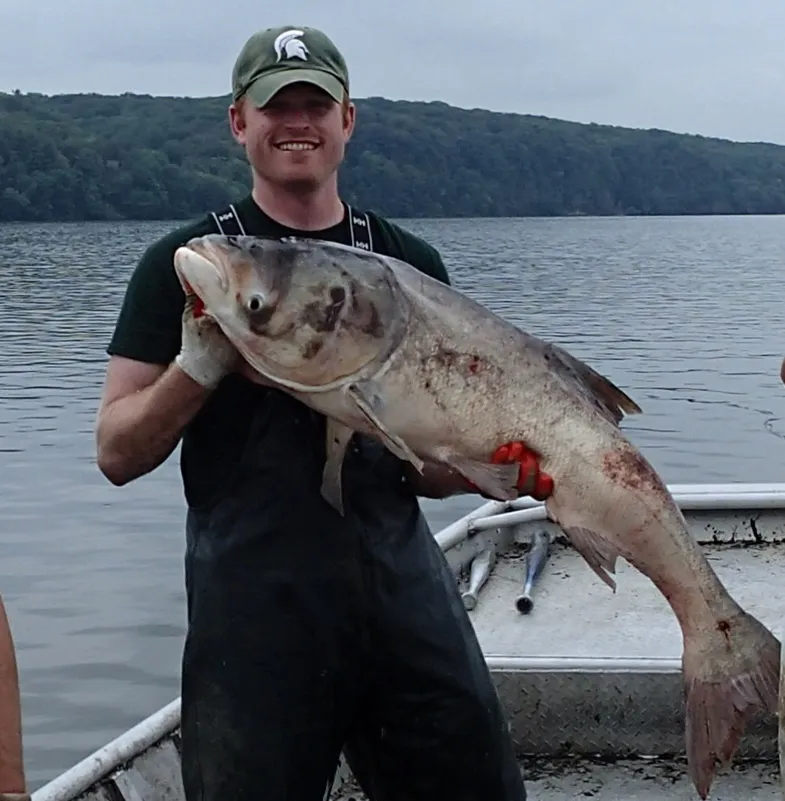An Update on Asian Carp

* This page contains affiliate links. The Great Lakes Fisherman may earn a commission on items purchased through these links. For more on this, please click here.
Unless you are new to the Great Lakes region, you have probably heard about the invasive carp. These fish have been the topic of serious debate over the last few decades among local, state, and federal officials as they pose a major threat to the Great Lakes ecosystem. Having been inadvertently released from rearing ponds in the south during flood events in the 1960s, these fish quickly spread throughout the south and lower Midwest in the 1970s, ’80s and ’90s.
Invasive Carp
In all, there are 4 species of carp that threaten the lakes: bighead carp, black carp, grass carp & silver carp. The grass carp has already been found in parts of the Great Lakes. The good news is that most of these fish were found to be sterile, likely because they were transplanted from private waters where triploid (sterile) versions of the fish are permitted. However, there have been some diploid (non-sterile) versions found over the last decade, mostly in Lake Erie tributaries. Efforts are underway there to eradicate these fish. For more on this, see the Lake Erie Grass Carp Adaptive Response Strategy.
The bighead and silver carp are the species of most concern due to a couple of factors. First, they are already present in the Illinois River System with only a man-made barrier currently keeping them at bay. Second, they have a very high reproduction rate and tend to dominate ecosystems wherever they establish themselves. The fear is that the Great Lakes could be over-run with these fish should they establish themselves on the other side of the barrier. So it should be no surprise that hundreds of millions of dollars have been and will continue to be spent on efforts to prevent their entry and protect our valuable resources.
Apart from the ecological threat, the silver carp also presents a physical threat due to a behavioral trait that makes them jump when startled. When boat motors run through large schools of these fish, they can jump out of the water by the hundreds. This can pose a serious safety hazard for those in the boat. Though the thought of it may seem funny, being hit by a 20-40 pound fish while travelling at high speeds is no laughing matter. People have suffered broken bones from collisions with the jumping fish.
Although the black carp is not yet geographically a direct threat to the lakes, their range continues to expand and they could one day become a bigger problem.
Recognizing the threat early, efforts began in the 1990’s to install barriers to prevent the carp from getting into the Great Lakes tributary system. The largest barrier in this effort to date was constructed on the Chicago Sanitary and Ship Canal (CSSC) and placed in service in 2002.
Known as the Electric Barriers, this facility establishes a continuous electric field across the waterway that will kill any carp that attempt to swim across it. But even with this barrier in place, there is concern among authorities that it is not enough, and only a matter of time before fish populations establish themselves on the other side.
Q & A with Seth Herbst of the MI-DNR
The Great Lakes Fisherman recently caught up with the Michigan Department of Natural Resources to find out more about the invasive (Asian) carp, their threat to the Great Lakes, and the latest measures being considered to prevent their entry.

Seth Herbst is the Aquatic Species and Regulatory Affairs Unit Manager with the DNR Fisheries Division. Prior to joining the MDNR in 2013, he earned his B.S. in Fisheries and Water Resources from University of Wisconsin-Stevens Point, M.S. in Aquatic Ecology and Watershed Science from the University of Vermont, and Ph.D. in Fisheries and Wildlife from Michigan State University. He also gained professional fisheries management experience working several seasons as a Fisheries
Technician with the Minnesota DNR and Wisconsin DNR. One of his primary responsibilities is to administer the Division’s aquatic invasive species (AIS) program. Additionally, he is an active member of numerous regional AIS committees in the Great Lakes region, such as the Invasive Carp Regional Coordinating Committee (ICRCC), a steering committee member for the Invasive Mussel Collaborative, a member of the Lake Erie Grass Carp Advisory Committee, and actively involved with the Great Lakes Panel for Aquatic Nuisance Species.
GLF: Which agencies are in charge of the efforts to prevent invasion of Asian carp into the Great Lakes, and how do they coordinate with state and provincial agencies in this effort?
SH: The state and provincial agencies have jurisdictional authority over the management of their respective fisheries resources, and that includes the prevention of invasive (previously Asian) carp into the Great Lakes. The state agencies actively collaborate with several federal agencies (i.e., U.S. Fish and Wildlife Service, U.S. Army Corps of Engineers, U.S. Geologic Survey, Department of Fisheries and Oceans Canada) to implement prevention and control measures to reduce the risk of bighead, silver, and black carp entering the Great Lakes. There are also several universities throughout the Midwest that contribute through research projects to advance the science of invasive carp deterrent technologies and also to evaluate innovative control methods. Additionally, NGOs [non-governmental organizations] have contributed to the issue through their advocacy efforts to promote this issue, so state and federal agencies are funded at a level necessary to effectively address the issue. The invasive carp efforts are largely financially supported through the Great Lakes Restoration Initiative (GLRI).
GLF: When we hear that invasive carp DNA has been found in the great lakes, what does that mean?
SH: When you hear invasive carp DNA, it typically refers to environmental DNA or eDNA and the means the DNA of specific species that is present in the environment as a result of genetic material being deposited. There are several potential sources that can lead to genetic material being present in the environment, such as live fish but genetic material can also come from external sources that are not associated with live fish in the waterbody of interest. The U.S. Fish and Wildlife Service implements an early detection surveillance program for bighead and silver carps throughout the Great Lakes Basin that relies on collecting waters samples and then analyzing those samples for the genetic material (i.e., eDNA) of bighead and silver carps. The eDNA results are typically reviewed by professionals to assess the risk of a positive detection. Typically, the higher proportion of positive samples from a sampling event or through time would result in more concern that live fish are present. Regardless, eDNA is one effective tool for early detection and results should be put in context with other sources of information to inform the presence of a fish species, such as traditional fisheries sampling methods and angler reports.
GLF: What are potential entry points of concern, other than through the Chicago River?
SH: The Chicago Area Waterway System is the location identified as the highest risk for the introduction of bighead, silver, and black carps into the Great Lakes. There were other connections identified during the Great Lakes Mississippi River Interbasin Study (GLMRIS) that was conducted several years ago, but those connections are lower risk and are already being mitigated through projects that removed the connections. For example, there was berm installed at Eagle Marsh in Indiana that addressed the connection between the Wabash River basin and the Lake Erie Basin that historically occurred during flooding events. The risk of introduction through the Chicago Area Waterway System is being addressed by advancing the state-of-the-art Brandon Road Lock and Dam project that would install technologies to deter fish from dispersing towards Lake Michigan from downstream areas in the Illinois River.
GLF: Besides the electric barriers in the CSSC, what other control measures are being seriously considered by authorities to prevent an invasion?
SH: There are several deterrent technologies that are being considered to prevent movement of invasive carps in riverine systems. The technologies include carbon dioxide, complex noise or acoustic stimuli, bioacoustics fish fence, and flushing jets to remove entrained fish from spaces between barges. You will notice that some of these technologies are also being recommended for the Brandon Road Lock and Dam project.
GLF: What are the economic, political, or other barriers that are could impede progress?
SH: The Brandon Road Lock and Dam project (see link above) would significantly reduce the risk of bighead, silver, and black carps entering the Great Lakes. This project, however, will come at an expense to the non-federal sponsor (State of Illinois and others willing to sign on) because the project at this time requires a 90:10 federal to non-federal sponsor financial support agreement. Therefore, a finalized project agreement might be a hurdle to overcome before the U.S. Army Corps can move forward with final design and construction.
GLF: If the carp get into the lakes, what are the most serious impacts that are expected to the ecosystem?
SH: Invasive carp pose significant ecological impacts and these impacts are described on our invasive carp website.
GLF: If carp do get into the system, what can be done to control their impacts?
SH: If invasive carp get introduced into the Great Lakes, the state would take aggressive actions to prevent the establishment of these species by implementing strategic actions identified in the Invasive Carp Management Plan. A priority would also be associated with limiting their ability to migrate upstream to complete their spawning activities. These species require open riverine environments to successfully spawn, so limiting their ability to make those upstream migrations would reduce the likelihood of establishment.
GLF: What can anglers do to help prevent a carp invasion?
SH: Anglers can report suspicious sighting of potential invasive carp using our Eyes in the Field reporting application. Also be sure to include a photo or video to help confirm identification because native fish species are commonly misidentified and thought to be invasive carp.
GLF: Is there anything else you would want anglers to know about invasive carp and the Great Lakes?
SH: The prevention of invasive carp is a top priority for our Governor and for the Department of Natural Resources. There is no evidence of established bighead, silver, and black carps in the Great Lakes and the DNR is working diligently to ensure these species don’t make their way into MI waters and the Great Lakes.
The Great Lakes Fisherman would like to thank Seth for taking the time to better inform us of the issues and efforts underway to protect our Midwest treasure. If there is more info that you’d like to learn regarding invasive carp or an other topic related to the Great Lakes fishery, please drop a comment below and let us know what’s on your mind.
